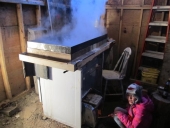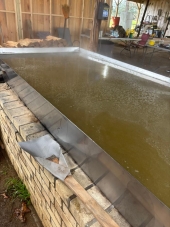


Glenn Herbert wrote:Welcome to Permies, Mark! For your restaurant-pan sized evaporator, your idea would probably work fine. You would really want to build an enclosure that the pan(s) could sit in with heat flow space underneath them, so you don't just have one super hot spot and ambient air around the edges. You might be able to get enough heat flow with a J-tube, but I think you would find that an L-tube works better and is easier to keep fed. Building an L-tube with an 8" wide x 9" high x 31" long firebox and a 27" or 31" total height riser (from the firebox floor) is very easy, requiring no firebrick cutting or real masonry skills, just large Lego stacking. See my photos above. The enclosure which you would need to build anyway to stabilize the core and pans can be just about anything, even stacked concrete blocks. You would need about 40 standard firebricks, and if you use blocks for the support structure, about 30 standard 8" concrete blocks. I like to use Durock or similar cement board for the firebox floor - it won't last forever but is cheap and easily replaceable. If you use firebrick for the floor, add another 16 or so to the brick total. You would want to fill the space between enclosure and firebrick core with perlite, best if mixed with a small amount of miscellaneous powdered clay and moistened before filling. This will support the firebricks securely.
All this material will cost hundreds of dollars less than a Dragon Heater core alone.



Glenn Herbert wrote:That first one was a bit undersized for the 8 sf pan. I added a couple of bricks to the L-tube length and it seemed to work better, but I never got the chance to really test it. It would work great for a 4 sf pan like the OP's, and could be built entirely in/on a base of a dead kitchen stove.

thomas rubino wrote:Ok;
You have a much smaller pan than I have seen in northern sugar shacks.
If it will fit over a barrel then that will work.
You may need to play with the diverter gap, it can't be too close.
For your "Work" force a 4x8 sheet of rigid insulation would work.
Be sure to use a good size exhaust stack.

thomas rubino wrote:Hey Greg;
Well, you are boiling sap so it's going to be hot.
If I'm understanding correctly, the barrel is open top and there to help shield the heat.
I would consider using an insulated riser, it would concentrate the heat inside the riser giving the most out of the top under your pans.
Yes, I think a diverter to spread the high heat across all your pans is a good idea.
Consider, using a steel box as a stratification chamber that collects the heat, and then have your vent pipe leave from the lower part of the box.
For the workers, you could use 4x8 sheets of the rigid foil face insulation board standing on the edge to block quite a bit of the radiant heat.
Lots of fresh cold water, maybe misting fans, start before dawn and quit after lunch?


thomas rubino wrote:Ha Ha, Well Greg you are talking to northern boys.
We know all about maple sap... and in my case virtually nothing about sugar cane.
Glenn is by far the more knowledgeable about this subject, Montana has no natural Maple trees or any sugar cane at all.
As far as consulting goes you could continue to ask and receive answers right here at Permies.
I am always open to a scheduled phone call but my evaporator knowledge is limited. (No charge) you can contact me at dragontech@blackfoot.net
Thank you. That is very kind and I may take you up on the offer.